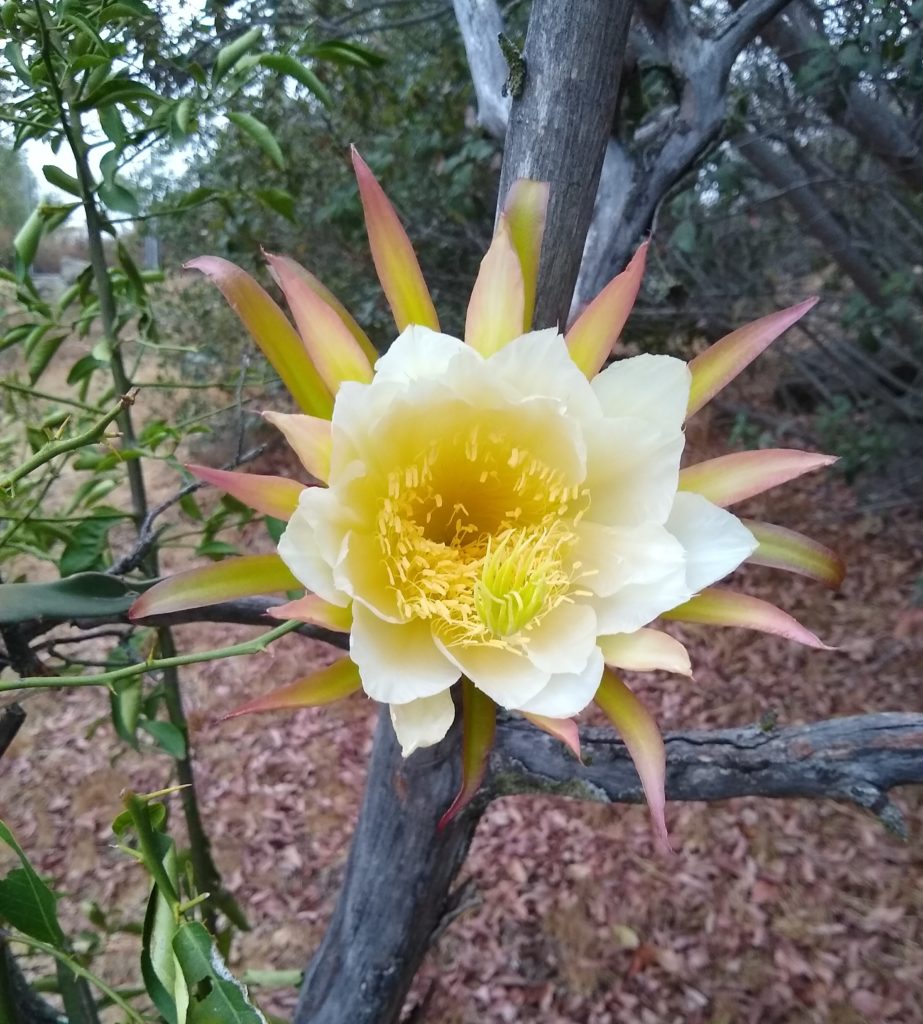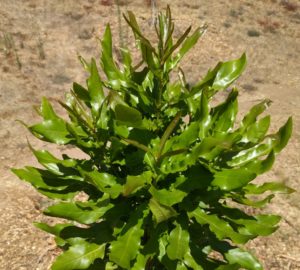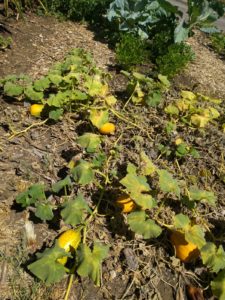In August we pass from mid summer into late summer, and some plants never want the season to end, such as the macadamia below.
Other plants start to look tired in August. Look at this weary butternut squash vine that I planted back in March:
It has fruited and is now ready for retirement.
Within the vegetable garden, August is a transition month. As we harvest warm-season crops, we must start sowing and planting cool-season crops. This way, for example, when your tomatoes stop producing well — around Thanksgiving time — you have potatoes to start harvesting.
Let’s get more specific.
Sow and plant
– Sow seeds of: (warm-season) basil, beans; (cool-season) broccoli, brussels sprouts, cabbage, cauliflower, kohlrabi, potatoes
*Note on sowing: it’s tough to keep the seeds of broccoli, etc. cool and moist enough in August if you sow them in the ground; I have better success sowing them in module trays that I keep in the relative cool and shade of my garage until the seeds have germinated (see photo below, and see details in my post “Starting brassicas in summer”); but hey, don’t sweat it if you don’t feel like growing these plants from seed — just wait to buy seedlings at a nursery in September
– Plant seedlings of: basil and beans
– Plant subtropical fruit trees like citrus and avocado, as well as vines like passion fruit; they love settling into the warm soil of mid summer; just be sure to water broadly and deeply at planting time, and then water frequently for the rest of the summer; see my post about how to water a newly planted avocado tree; this schedule for avocados can be used for citrus, macadamias, mangos, passion fruit and other subtropicals too
Harvest and eat
– Eat these vegetables (had you planted them): tomatoes, tomatillos, potatoes, corn, greens, onion, beets, carrots, peppers, eggplant, squash, basil, cucumber, melons, beans
– Eat these berries and fruits (had you planted them): grapes, avocados (Lamb, Reed), Valencia oranges, peaches, nectarines, plums, pluots, dragon fruit

Miscellaneous
– Here in August is the last great time this year to give a deciduous fruit tree a trim, particularly on the top, if you want it to continue making its fruit on branches low enough for you to reach in the coming years; reducing the top growth lets more light onto lower branches, which induces them to form flower buds that will open next spring; the types of trees that I give summer trims to in my yard include peaches, nectarines, apricots, plums, and pluots; see more in my post “Summer pruning deciduous fruit trees”
– Consider increasing the frequency of watering; in every year in every garden I’ve had in Southern California, irrigation is needed more often in August than other months; for example, my vegetables now need watering every other day whereas in July they did fine getting water every three days
All of my Yard Posts are listed HERE
You might also like to read my post:







Love these monthly updates!
Yikes! I didn’t realized the fruit trees need pruning now!
I had better get busy!!
Thanks! Is it good time for potted avocado to go in ground? I thought I had to wait until it was cooler. I’m in Los Angeles County area and its been HOT
Hi Nancy,
August is a fine time to put a potted avocado in the ground as long as you care for it properly. In fact, I planted one on July 29 and the daily high temps have been 97-99 in my yard during the four days since then, and the little tree is managing happily.
What you must do in such summer heat is water every day for the first week it’s in the ground, about every other day during the second week, and maybe every three days from the third week until the end of summer. See my post “How to water a newly planted avocado tree” for this schedule and approximately how many gallons to give the tree at each watering.
The other vital care the tree will need is shade unless it’s been sitting in full sun for a couple weeks before planting. (Usually, trees at nurseries are not in full sun but rather crowded together with other trees.) See my post “How to plant and stake an avocado tree” and my post “Avocado trees get sunburned — What to do?” for pictures and details about how to shade new trees that are planted in summer.
One last thing that the tree will really appreciate is mulch. That will help the soil stay a bit cooler and moist longer.
It requires more attention to plant an avocado tree in August compared to the cooler months of the year, but if you can give them that attention they thrive. Best of luck!
Hi Greg, thanks for the answer.
I was wondering same question as Nancy. Many ppl said should wait till fall, but Gary from Laguna Hills nursery says heat loving plants like avocados are fine to plant in Summer. I’ll do with shade and extra watering as you mentioned.
Thank you again!
Does planting in a vegetable box count as planting in the ground?
Hi Bev,
Good question. Glad you asked. Yes, what I mean by sowing broccoli, cauliflower, and cabbage “in the ground” is sowing them outside in the garden as opposed to in some kind of tray or pot that you plan to shade or move or otherwise protect from the weather.
Okay. Than you.
I’ve always randomly planned whatever was available in the nursery (Armstrong). Now that I have more time, I want to be more systematic as to what I grow and when. So it sounds like I should be sowing seeds rather than planting in the box. I live in Pacific Palisades so get wet mornings even now in the summer.
Hi Bev,
You can have better success through some planning although good nurseries like Armstrong don’t often carry vegetable seedlings that shouldn’t be planted at a particular time. They’re more reliable than a place like Home Depot. Nevertheless, I bet Armstrong is still carrying tomatoes here in mid-August. If you planted tomatoes right now, you’d get some fruit in the fall but not much. Now is not a good time to plant tomatoes even though it’s possible to get a little harvest out of such a planting.
If you haven’t already, see my post, “Which vegetables can I plant now in Southern California?” There you’ll find a couple of good vegetable planting calendars.
In the monthly posts that I’ve written (such as this one above for August), I try to get a little nuanced about when and why to sow or plant certain vegetables at certain times. I think they’re a good complement to the vegetable planting calendars.
There are advantages and drawbacks to sowing seeds versus buying seedlings from the nursery. I do a combination of both in most years. I wrote this post to help people decide what’s best for them: “Should you grow vegetables from seeds or plants?”
It has been a rough summer in the desert this year (Palm Springs). I planted two Hass last fall as an experiment. Both died in July. I have three young apples that have been thriving for two years, but are now looking super tired (two Anna, one Gordon). Is watering every day too much for apples?
Hi Tanya,
I’ve been following the temperatures in Palm Springs. Yikes! It has been a hot summer indeed.
Sorry about your avocados. Curious if you had them shaded and how you were watering them.
It could be fine to water your apples every day, especially if you’re using drip, but it partly depends on how much you’re watering each day plus how sandy your soil is (the sandier the more often you need to water).
You might try to get some shade over the trees for the rest of summer. Even in Washington some farmers lightly shade their apple trees. And even where I am in Ramona I get some sunburn on apples that are not shaded.
Hi Greg! I just found your gardening site and love it. So much info for our area of gardening which can be challenging with the heat.
Do you have a recommendation for an Apple tree? I live in Chino CA and it is hot.
Thanks, Jane. My climate in Ramona, San Diego County, is similar to Chino. In my yard, Gala, Pink Lady, Fuji, and Granny Smith have all done very well.
In other yards that I know that are near you (in Pomona and Corona, e.g.), those varieties also do well, plus Anna, Dorsett Golden, and Beverly Hills have done well.
Hi Greg, can you give us an update on your Linda Macadamia nut tree, you posted this in 2017.
Any flowers or nuts yet? How big has it grown?
I planted a Linda about 1 year ago, I have no idea what to expect, it has not grown much in 1 year) But My Cate Macadamia nut tree that I planted at the same time, is now 3 times the size of my Linda.
Hi Robin,
No flowers or nuts yet from the Linda macadamia. The tree has finally taken off in growth though. Like yours, it didn’t do much in the first year or two. It’s about 10 feet tall. My guess is that it will flower next year or after one more year.
On a side note, I planted a Jordan macadamia tree beside the Linda, but the Jordan grew very poorly. Looking at its roots after I cut it down last year made me think it was because the tree had been rootbound and girdling itself when I transplanted it. It can be hard to tell how healthy a potted tree’s root system is when you buy it.
Has your Linda Macadamia Nut Tree produced yet?
Thanks
Hi Matt,
Nothing, not even flowers from the tree. But it’s growing well, at about 12 feet tall now.
Thanks for the update, sounds like it’s close.
I need advice on crop rotation. I have a 16×12 full sun garden. I’ve just wrapped up a moderate production of tomatoes but compared to previous years, it was disappointing. I suspect soil exhaustion. So what to plant to restore the depleted nutrients in my garden, in this transition month of August?
Hi Scott,
There are lots of ways to increase soil fertility in a vegetable garden, but my preferred way is by adding a couple of inches of compost to the surface. It’s simple, safe, easy, effective for every crop, and doesn’t stop you from continuing to plant whatever you want. One downside is that it usually takes a couple weeks to start noticing the enhanced fertility.
Maybe you’d enjoy reading this post: https://gregalder.com/yardposts/fertile-soil-can-be-childs-play/
Hi Greg!
What type of beans do you recommend sowing in August in SoCal? I’m in the San Gabriel Valley.
Thanks!
Hi Adrien,
You can probably get a decent harvest from any kind of bean if sown right now — green beans or dry beans like black beans or pinto.
Thanks for the tip about shade! I’ll be picking up some shade cloth tomorrow. Our monsoon season was delayed until now, so it has been hot and dry here in Palm Springs. Hopefully, the influx of a little moister air will help. I have ring troughs dug around my trees and run the hose slowly in each ring until the burms overflow. I have super rocky, sandy soil. It’s a challenge.
Great website! i love all the info from a So Cal local. Do you ever keep an avocado in a pot? if so, how big should the pot be, and what kind of care would it need?
Hi Li,
I always have a few avocados in pots, but I don’t have any in pots long term. The size of the pot needs to be aligned with the size of the tree. If you look at avocado trees in a nursery, you can get an idea of how big the pot needs to be compared to the size of the tree. Usually, avocado trees in a nursery have “filled out” their pots. That is, the roots have grown throughout the pot and the tree needs to be planted in the ground or up-potted soon.
The most important care you can give an avocado tree in a pot is enough and timely watering. They don’t like to dry out.
Hello Greg,
Hoping this feed is still active. I frequently visit Ramona to shop and such. I live near Scissors Crossing, east of Julian. Are you familiar with the Aldis in Ramona? I love the bushes with the yellow flowers. I’m not sure what the bush is or if it will thrive in the desert. I also frequently visit Borrego Springs, I see a similar bush, yet they are alot smaller.
Another pondering for my area, is the well water. It’s supposed to be high in magnesium. Does this have an impact on vegetables, if I were to have a garden.
Hi Greg,
Did you see this? Yikes! https://www.kpbs.org/news/2021/aug/05/first-cases-citrus-tree-killing-disease-hlb-found-/
Hi Jane,
Yes. Here’s the press release about the finding and quarantine from the California Department of Food and Agriculture: https://www.cdfa.ca.gov/egov/Press_Releases/Press_Release.asp?PRnum=21-091
I live in Sacramento, California- and its my hope that I can set up an area to plant/grow a fuente avocado tree.
I think the big problems that I will face include:
1) I understand that I need another avocado tree – so I can get ‘decent’ pollenazation to the fuente and get some avocado’s off it. My understanding is that it cannot be a fuente- is there a best species to pollinate the fuente?
2) Soil and drainage for the fuente
I think the biggest issue I face is that I understand that fuente’s need good/great drainage- and a lot of water. Watering the tree is not an issue- I think the biggest challenge I will have is soil- we have a clay/rocky soil and it does not drain well.
I do have a large drainage culvert (city drain designed for 1,000 of gallons or rainwater) that is about 15 feet from where I would like to plant the fuente. Its my current plan to run several 3 in landscape drainage pipes- set up like a french drain -under the tree. My hope is that if I I can place enough drainage under the tree, I can I can keep it healthy.
Would anyone have any advice or perhaps know an expert that is in the Sacramento area that I could meet?